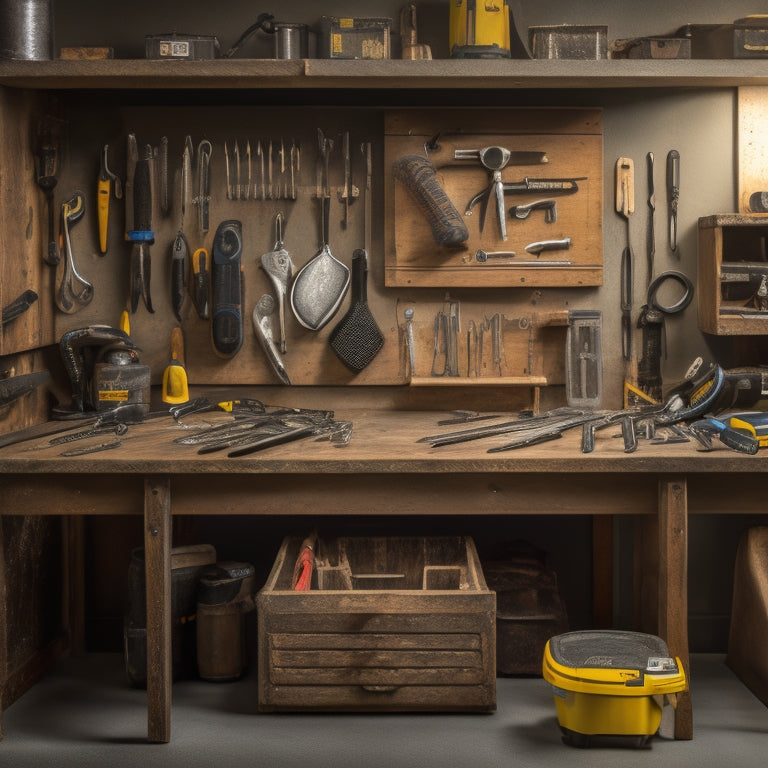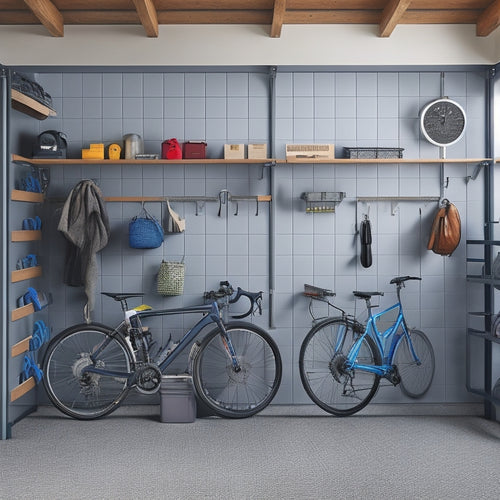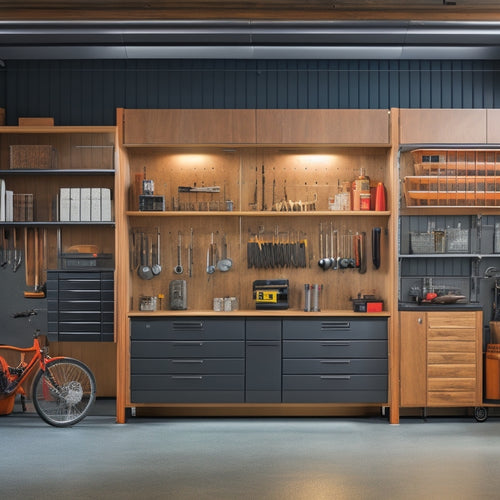
What Makes a Small Tool Organizer Good for Your Workshop
Share
You need a well-designed small tool organizer to unveil the full potential of your workshop by maximizing space, reducing clutter, and enhancing productivity. A good organizer should have a compact design that saves space, easy access to tools to reduce downtime, and features that promote visibility of your tool inventory. It should also reduce clutter and chaos, increasing your productivity levels and allowing for customizable storage options and portability. With a small tool organizer, you'll experience improved workflow efficiency, time-saving tool management, and enhanced workshop safety. As you implement these features, you'll uncover more ways to optimize your workshop's performance.
Key Takeaways
- A small tool organizer is good for your workshop if it optimizes space, fits snugly in corners or against walls, and reduces visual clutter.
- It should provide easy access to tools, categorizing them by function or frequency of use, and feature labeled compartments or dividers for enhanced visibility.
- A good small tool organizer reduces clutter and chaos, enabling easy access storage, and promotes improved tool visibility, leading to efficient workspace management.
- It should be customizable and portable, allowing tailoring of storage space to fit specific tool collections, and facilitating easy transport of tools with ergonomic handles.
- Durability and safety are also crucial, with tough materials resisting rust and corrosion, and proper organization reducing the risk of tool-related injuries and tripping hazards.
Compact Design Saves Space
Your workshop's limited real estate is valuable, and every inch counts. That's why a compact design is essential for your small tool organizer. With space optimization in mind, you can make the most of your workshop's limited space.
A well-designed organizer should fit snugly into a corner or against a wall, maximizing vertical space and keeping your tools within easy reach.
When it comes to design aesthetics, a compact organizer should be sleek and unobtrusive. Look for a design that blends seamlessly into your workshop's decor, rather than one that stands out like a sore thumb.
A compact design also means less visual clutter, making it easier to focus on the task at hand. By choosing an organizer that prioritizes space optimization, you'll be able to work more efficiently and safely, without the distraction of cluttered workbenches or tripping hazards.
Easy Access to Tools
A well-stocked workshop is only as good as its accessibility. When you need a specific tool, you shouldn't have to waste time searching for it. A small tool organizer with easy access to tools guarantees you can quickly retrieve what you need, reducing downtime and increasing productivity.
Effective organization strategies, such as categorizing tools by function or frequency of use, can streamline tool retrieval. A small tool organizer with labeled compartments or dividers helps you find the right tool quickly. You can also consider a rotating organizer or a pegboard with hooks to maximize accessibility.
Additionally, consider the height and placement of your tool organizer. Mount it at a comfortable height to avoid straining your back or neck when reaching for tools. By optimizing tool access, you'll work more efficiently and safely.
With easy access to tools, you'll be able to focus on the task at hand, rather than wasting time searching for what you need.
Reduced Clutter and Chaos
When you implement a small tool organizer in your workshop, you'll enjoy the benefits of easy access storage, which means you can quickly grab the tool you need without having to sift through a jumbled mess.
With a well-organized workspace, you'll also gain clear visibility of your tools and materials, allowing you to work more efficiently and effectively.
Easy Access Storage
Cluttered workbenches and chaotic workshops are a thing of the past with easy access storage solutions. You'll appreciate the convenience of being able to quickly find the tools you need, without having to dig through a disorganized mess.
Easy access storage guarantees that your tools are neatly stored and readily available, allowing you to focus on the task at hand. This means you'll spend less time searching for misplaced tools and more time getting work done.
With easy access storage, you can enjoy improved tool accessibility and organized retrieval. This is especially important in a workshop where every minute counts.
You can't afford to waste time hunting for a specific tool or part. Easy access storage solutions, such as small tool organizers, keep your tools within easy reach, making it simple to grab what you need and get back to work.
This not only saves time but also reduces frustration and increases productivity. By keeping your tools organized and easily accessible, you can work more efficiently and safely, guaranteeing a better workshop experience.
Clear Visibility Workspace
You'll work more efficiently in a space where everything has its designated place, and you can see exactly what you need at a glance. A clear visibility workspace is essential for a productive and safe workshop.
With a small tool organizer, you can achieve this by assigning a specific spot for each tool, making it easy to identify and access the tool you need. This organization system guarantees that your workspace remains clutter-free, reducing the risk of accidents caused by tripping over tools or misplacing them.
When everything is in its place, you can focus on the task at hand without wasting time searching for a specific tool. Improved tool visibility also helps you maintain your tools better, as you can quickly spot any damage or wear and tear.
A well-organized workspace also promotes a sense of control and calm, allowing you to work with precision and confidence. By implementing a small tool organizer, you can create a workspace that's both efficient and safe, where you can work comfortably and effectively.
Increased Productivity Levels
With a small tool organizer, you'll experience increased productivity levels as you're able to quickly grab the tools you need, reducing the time wasted searching for them.
This efficient workflow management enables you to complete tasks faster, allowing you to tackle more projects in less time.
Fast Access to Tools
Having a small tool organizer in your workshop means that your frequently used tools are always within arm's reach, allowing you to switch between tasks quickly and effortlessly. This fast access to tools greatly enhances your productivity levels, as you can complete tasks efficiently without wasting time searching for the right tool.
With a well-organized workshop, you can maintain a smooth workflow, which in turn, improves your overall workshop efficiency.
Tool accessibility is vital in a workshop, and a small tool organizer guarantees that your essential tools are easily accessible. This accessibility enables you to work safely, as you're less likely to misplace tools or use the wrong ones, which can lead to accidents or damage to your projects.
Reduced Time Wasted
By keeping your tools organized, you're not only ensuring fast access to the tools you need, but you're also slashing the time spent searching for them.
This reduction in tool time translates to increased productivity levels, allowing you to complete projects more efficiently. A well-organized workshop means you'll no longer waste precious minutes searching for misplaced tools or supplies.
With a small tool organizer, you can implement effective organization strategies that keep your tools within easy reach, freeing up more time for actual work.
Efficient Workflow Management
Three key areas of your workshop benefit from efficient workflow management: tool selection, task prioritization, and workspace optimization. By implementing effective workflow strategies, you can streamline your work process and achieve increased productivity levels.
A small tool organizer plays an essential role in this process by allowing you to categorize your tools in a logical and accessible manner. This means you can quickly identify the tools you need for a specific task, reducing the time spent searching for them.
With your tools organized, you can focus on prioritizing your tasks, ensuring that you're tackling the most vital projects first. A well-organized workspace also helps you avoid distractions and stay focused on the task at hand.
Customizable Storage Options
With your small tool organizer, you can tailor your storage space to fit your specific needs. This customization is essential in maintaining a safe and efficient workshop.
You can create modular configurations that adapt to your unique tool collection, ensuring that each item has a designated spot. Adjustable dividers allow you to separate tools of varying sizes, preventing clutter and potential hazards.
You can also allocate specific areas for frequently used tools, keeping them within easy reach. This streamlines your workflow, saving time and reducing the risk of accidents caused by misplaced tools.
Additionally, customizable storage options enable you to store small parts and accessories in a way that makes sense for your workflow. By keeping them organized and visible, you can quickly identify what you need, reducing mistakes and improving overall productivity.
With a small tool organizer that accommodates your specific needs, you can focus on the task at hand, knowing that your tools are safely and efficiently stored.
Durability and Long-Lasting Use
You need a small tool organizer that can withstand the rigors of your workshop, and that's why you should look for one constructed with tough materials that can resist rust and corrosion.
This type of construction guarantees your organizer remains sturdy and functional over time, even in harsh environments.
Tough Material Construction
Most small tool organizers on the market boast a sturdy build, but few can match the rugged durability of this particular model. You'll appreciate the strong construction that can withstand the rigors of daily use in your workshop.
The organizer's frame is typically made from heavy-duty materials like steel or aluminum, providing exceptional strength and impact resistance. This guarantees that your tools remain secure and organized, even in the face of accidental knocks or drops.
The material types used in the construction of the organizer are also critical to its durability. Look for organizers made from high-quality polymers or ABS plastics, which offer excellent resistance to cracks and breaks.
Additionally, the organizer's components, such as the drawers and trays, should be designed to withstand heavy use and frequent opening and closing. By choosing an organizer built with tough, long-lasting materials, you can enjoy years of reliable service and minimize the risk of accidents caused by faulty or broken equipment.
Resists Rust and Corrosion
Rust and corrosion can wreak havoc on your small tool organizer, compromising its structural integrity and rendering it useless. You need a small tool organizer that resists rust and corrosion to guarantee durability and long-lasting use. This is where material selection comes in. Look for organizers made from materials like stainless steel, aluminum, or powder-coated steel, which are naturally resistant to corrosion.
| Material | Corrosion Resistance | Maintenance Tips |
|---|---|---|
| Stainless Steel | High | Regularly clean with a soft cloth |
| Aluminum | Medium | Avoid exposure to saltwater |
| Powder-Coated Steel | High | Inspect for scratches and touch up paint |
| Carbon Steel | Low | Apply rust-resistant coating regularly |
| Wood | None | Seal with waterproof coating |
Additionally, proper maintenance is vital in preventing rust and corrosion. Regularly clean your organizer, avoid exposing it to harsh chemicals, and store it in a dry place. By considering the material selection and following these maintenance tips, you can guarantee your small tool organizer remains rust-free and functional for years to come.
Portability and Convenience
The workshop's versatility demands a tool organizer that can keep up, and that's where portability and convenience come into play. You need a system that allows you to easily transport your tools to different workstations or job sites, without compromising your workflow.
A good small tool organizer should be designed with tool transportation in mind, ensuring that your tools are safely and securely stored during transit.
When evaluating a tool organizer, consider the following features that promote portability and convenience:
-
Lightweight and compact designs that make it easy to carry or move the organizer around your workshop.
-
Ergonomic handles or grips that provide a comfortable and secure hold, reducing fatigue during transportation.
-
Modular components that allow you to customize the organizer to fit your specific toolset and workflow, making it easy to add or remove tools as needed.
Visibility of Tool Inventory
Having a clear view of your tool inventory is essential for efficient workflow management, as it enables you to quickly identify what tools are available and where they're located, saving you time and frustration.
When you can see what you have, you can plan your projects more effectively and avoid delays caused by missing tools. A good small tool organizer should provide easy tool identification, allowing you to identify tools at a glance. This is especially important in a workshop where safety is a top priority, as it helps prevent accidents caused by using the wrong tool for the job.
A well-organized inventory tracking system also helps you keep track of tool maintenance and calibration schedules, ensuring your tools are in good working condition. This not only improves safety but also prolongs the life of your tools.
With a clear view of your tool inventory, you can also identify tools that need to be replaced or reordered, reducing downtime and increasing productivity. By keeping your tools organized and easily accessible, you can focus on getting the job done efficiently and safely.
Time-Saving Tool Management
One of the most significant advantages of a well-organized tool inventory is that it saves you a substantial amount of time. When you know exactly where each tool is, you can quickly locate what you need, reducing downtime and increasing productivity.
A small tool organizer helps you establish effective tool categorization strategies and organizational habits, ensuring that every tool has a designated place.
By implementing a well-structured tool management system, you can:
-
Reduce search time: No more wasting minutes searching for a misplaced tool. With a small tool organizer, you can find what you need in seconds.
-
Minimize tool duplication: By keeping track of your tools, you can avoid buying duplicates and save money.
-
Streamline your workflow: With a well-organized tool inventory, you can focus on the task at hand, rather than wasting time searching for the right tool.
Improved Workshop Safety
Nearly 80% of workshop accidents occur due to misplaced or poorly stored tools, making a small tool organizer an essential investment for any serious DIY enthusiast or professional.
By implementing proper storage and organization techniques, you greatly reduce the risk of tool-related injuries and accidents. A well-organized workshop also promotes good user habits, encouraging you to maintain your tools regularly and verify they're in good working condition.
A small tool organizer helps you comply with safety regulations and maintain a clutter-free workshop, reducing tripping hazards and preventing tools from falling off workbenches.
It also enables you to adopt ergonomic practices, keeping frequently used tools within easy reach and reducing strain on your body. By keeping your tools organized, you're more likely to perform routine maintenance practices, such as cleaning and lubricating your tools, which is critical for tool safety and injury prevention.
Frequently Asked Questions
What Is the Ideal Size of a Small Tool Organizer for a Home Workshop?
When choosing a small tool organizer for your home workshop, you'll want a compact design that measures around 12-18 inches wide and 6-8 inches deep, providing efficient storage without taking up too much space.
Can a Small Tool Organizer Be Mounted on a Pegboard or Wall?
You'll want to ascertain your small tool organizer is compatible with your pegboard or can be securely mounted on a wall, providing easy access while keeping your workspace clutter-free and safe from tripping hazards.
Do Small Tool Organizers Come With Pre-Drilled Holes for Easy Installation?
"Cut to the chase" and get straight to installing your small tool organizer - you'll be thrilled to know that many come with pre-drilled holes, offering pre-drilled convenience and installation ease, so you can get organized and back to work safely and efficiently!
Can a Small Tool Organizer Be Used to Store Power Tool Accessories?
You'll find that many small tool organizers are designed with power tool storage in mind, offering dedicated spaces for accessory compatibility, ensuring your drill bits, saw blades, and other attachments are securely stored and easily accessible.
Are Small Tool Organizers Suitable for Outdoor or Harsh Environment Use?
When you're battling the elements, you need a small tool organizer that's as tough as you are. Look for weather-resistant designs and materials with proven durability to guarantee your tools stay protected, no matter the weather or work site conditions you're facing.
Conclusion
As you stand in your workshop, surrounded by the chaos of scattered tools, think of a small tool organizer as a guiding light of hope, shining a light on the path to productivity. Just as a skilled navigator charts a course through treacherous waters, a well-designed organizer steers you clear of wasted time and energy, guiding you towards a haven of efficiency and precision. With every tool in its place, you'll sail smoothly through even the most complex projects.
Related Posts
-

Key Features of a Garage Wall Hanging System
You're looking for a garage wall hanging system that's built to last and adapts to your needs. Look for systems made ...
-

Best Materials for Garage Wall-Mounted Cabinets
When selecting materials for your garage wall-mounted cabinets, you'll want to evaluate options that balance durabili...
-

Must-Try Bike Storage Ideas in Small Spaces
You're tired of sacrificing precious living space to store your bike, especially in small homes where every square fo...


